Energy Performance and Comfort Analysis of Three Glazing Materials with Distinct Thermochromic Responses as Roller Shade Alternative in Cooling- and Heating-Dominated Climates
Abstract
1. Introduction
2. Materials and Methods
2.1. Model
2.2. Window Configuration
2.3. Thermal and Lighting Simulations
- From 0 to 500 lux (UDI<500): under-lit; insufficient illuminance, reliant on artificial lighting to eliminate visual discomfort.
- From 500 to 2000 lux (UDI500–2000): well lit; adequate illuminance.
- Above 2000 lux (UDI>2000): over-lit; excessive illuminance, causes visual discomfort.
3. Results and Discussion
3.1. Energy Savings by Orientation (40% WWR)
3.2. Energy Savings by End-Use (40% WWR)
3.3. Thermochromic Behaviour of Glazing and Shade Deployment (40% WWR)
3.4. Daylighting Performance (40% WWR)
3.5. Energy Savings and Daylighting Performance by WWR (40–80%)
4. Conclusions
Supplementary Materials
Author Contributions
Funding
Data Availability Statement
Conflicts of Interest
Abbreviations
| Abbreviation | Meaning |
| Asol | Solar absorptance |
| BI | Balanced illuminance |
| CDD65 | Cooling degree days (65 F) |
| Thermal emittance | |
| Thermal modulation efficiency | |
| HDD65 | Heating degree days (65 F) |
| HIGU | Hydrogel incorporated IGU |
| HVAC | Heating, ventilation, and air conditioning |
| IGU | Insulated glass unit |
| NIR | Near-infrared |
| NoTC | Reference IGU with clear glass |
| ORS | RSo incorporated IGU |
| PIGU | TC-Perovskite-incorporated IGU |
| PNIPAm | Poly(N-isopropylacrylamide) |
| RS | Roller shades |
| RSo | Opaque roller shades |
| RSt | Transparent roller shades |
| TC | Thermochromic |
| Tc | Critical transition temperature |
| TIR | Thermal infrared |
| Tlum | Visible light transmittance |
| TRS | RSt incorporated IGU |
| Tsol | Solar transmittance |
| ΔTsol | Solar modulation efficiency |
| UDI | Useful daylight illuminance |
| UV | Ultraviolet |
| VIGU | VO2-incorporated IGU |
| VO2 | Vanadium dioxide |
| WWR | Window-to-wall ratio |
References
- Kerry, J.; McCarthy, G. The Long-Term Strategy of the United States, Pathways to Net-Zero Greenhouse Gas Emissions by 2050; The United States Department of State and the United States Executive Office of the President: Washington, DC, USA, 2021.
- Aldhshan, S.R.; Abdul Maulud, K.N.; Wan Mohd Jaafar, W.S.; Karim, O.A.; Pradhan, B. Energy consumption and spatial assessment of renewable energy penetration and building energy efficiency in Malaysia: A review. Sustainability 2021, 13, 9244. [Google Scholar] [CrossRef]
- Lee, J.-W.; Jung, H.-J.; Park, J.-Y.; Lee, J.; Yoon, Y. Optimization of building window system in Asian regions by analyzing solar heat gain and daylighting elements. Renew. Energy 2013, 50, 522–531. [Google Scholar] [CrossRef]
- Jelle, B.P.; Hynd, A.; Gustavsen, A.; Arasteh, D.; Goudey, H.; Hart, R. Fenestration of today and tomorrow: A state-of-the-art review and future research opportunities. Sol. Energy Mater. Sol. Cells 2012, 96, 1–28. [Google Scholar] [CrossRef]
- Elghamry, R.; Hassan, H. Impact of window parameters on the building envelope on the thermal comfort, energy consumption and cost and environment. Int. J. Vent. 2020, 19, 233–259. [Google Scholar] [CrossRef]
- Goia, F. Search for the optimal window-to-wall ratio in office buildings in different European climates and the implications on total energy saving potential. Sol. Energy 2016, 132, 467–492. [Google Scholar] [CrossRef]
- Troup, L.; Phillips, R.; Eckelman, M.J.; Fannon, D. Effect of window-to-wall ratio on measured energy consumption in US office buildings. Energy Build. 2019, 203, 109434. [Google Scholar] [CrossRef]
- Evola, G.; Gullo, F.; Marletta, L. The role of shading devices to improve thermal and visual comfort in existing glazed buildings. Energy Procedia 2017, 134, 346–355. [Google Scholar] [CrossRef]
- Wankanapon, P.; Mistrick, R.G. Roller shades and automatic lighting control with solar radiation control strategies. Int. J. Build. Urban Inter. Landsc. Technol. 2011, 1, 37–46. [Google Scholar]
- Kamaruzzaman, S.N.; Edwards, R.; Zawawi, E.M.A.; Che-Ani, A.I. Achieving energy and cost savings through simple daylighting control in tropical historic buildings. Energy Build. 2015, 90, 85–93. [Google Scholar] [CrossRef]
- Chen, Y.; Liu, J.; Pei, J.; Cao, X.; Chen, Q.; Jiang, Y. Experimental and simulation study on the performance of daylighting in an industrial building and its energy saving potential. Energy Build. 2014, 73, 184–191. [Google Scholar] [CrossRef]
- Choi, Y.; Ozaki, A.; Lee, H. Impact of window frames on annual energy consumption of residential buildings and its contribution to CO2 emission reductions at the city scale. Energies 2022, 15, 3692. [Google Scholar] [CrossRef]
- Jiang, W.; Liu, B.; Zhang, X.; Zhang, T.; Li, D.; Ma, L. Energy performance of window with PCM frame. Sustain. Energy Technol. Assess. 2021, 45, 101109. [Google Scholar] [CrossRef]
- Hee, W.; Alghoul, M.; Bakhtyar, B.; Elayeb, O.; Shameri, M.; Alrubaih, M.; Sopian, K. The role of window glazing on daylighting and energy saving in buildings. Renew. Sustain. Energy Rev. 2015, 42, 323–343. [Google Scholar] [CrossRef]
- Buratti, C.; Moretti, E. Glazing systems with silica aerogel for energy savings in buildings. Appl. Energy 2012, 98, 396–403. [Google Scholar] [CrossRef]
- Yin, R.; Xu, P.; Shen, P. Case study: Energy savings from solar window film in two commercial buildings in Shanghai. Energy Build. 2012, 45, 132–140. [Google Scholar] [CrossRef]
- Li, S.-Y.; Niklasson, G.A.; Granqvist, C.-G. Nanothermochromics: Calculations for VO2 nanoparticles in dielectric hosts show much improved luminous transmittance and solar energy transmittance modulation. J. Appl. Phys. 2010, 108, 063525. [Google Scholar] [CrossRef]
- Shen, N.; Chen, S.; Shi, R.; Niu, S.; Amini, A.; Cheng, C. Phase transition hysteresis of tungsten doped VO2 synergistically boosts the function of smart windows in ambient conditions. ACS Appl. Electron. Mater. 2021, 3, 3648–3656. [Google Scholar] [CrossRef]
- Ji, C.; Wu, Z.; Wu, X.; Wang, J.; Gou, J.; Huang, Z.; Zhou, H.; Yao, W.; Jiang, Y. Al-doped VO2 films as smart window coatings: Reduced phase transition temperature and improved thermochromic performance. Sol. Energy Mater. Sol. Cells 2018, 176, 174–180. [Google Scholar] [CrossRef]
- Dietrich, M.K.; Kramm, B.G.; Becker, M.; Meyer, B.K.; Polity, A.; Klar, P.J. Influence of doping with alkaline earth metals on the optical properties of thermochromic VO2. J. Appl. Phys. 2015, 117, 185301. [Google Scholar] [CrossRef]
- Li, X.-H.; Liu, C.; Feng, S.-P.; Fang, N.X. Broadband light management with thermochromic hydrogel microparticles for smart windows. Joule 2019, 3, 290–302. [Google Scholar] [CrossRef]
- Lin, C.; Hur, J.; Chao, C.Y.; Liu, G.; Yao, S.; Li, W.; Huang, B. All-weather thermochromic windows for synchronous solar and thermal radiation regulation. Sci. Adv. 2022, 8, eabn7359. [Google Scholar] [CrossRef] [PubMed]
- Zhou, Y.; Cai, Y.; Hu, X.; Long, Y. Temperature-responsive hydrogel with ultra-large solar modulation and high luminous transmission for “smart window” applications. J. Mater. Chem. A 2014, 2, 13550–13555. [Google Scholar] [CrossRef]
- Ke, Y.; Zhou, C.; Zhou, Y.; Wang, S.; Chan, S.H.; Long, Y. Emerging thermal-responsive materials and integrated techniques targeting the energy-efficient smart window application. Adv. Funct. Mater. 2018, 28, 1800113. [Google Scholar] [CrossRef]
- Liu, S.; Li, Y.; Wang, Y.; Yu, K.M.; Huang, B.; Tso, C.Y. Near-infrared-activated thermochromic Perovskite smart windows. Adv. Sci. 2022, 9, 2106090. [Google Scholar] [CrossRef] [PubMed]
- Liu, S.; Du, Y.W.; Tso, C.Y.; Lee, H.H.; Cheng, R.; Feng, S.P.; Yu, K.M. Organic hybrid perovskite (MAPbI3−xClx) for thermochromic smart window with strong optical regulation ability, low transition temperature, and narrow hysteresis width. Adv. Funct. Mater. 2021, 31, 2010426. [Google Scholar] [CrossRef]
- Rosales, B.A.; Mundt, L.E.; Allen, T.G.; Moore, D.T.; Prince, K.J.; Wolden, C.A.; Rumbles, G.; Schelhas, L.T.; Wheeler, L.M. Reversible multicolor chromism in layered formamidinium metal halide perovskites. Nat. Commun. 2020, 11, 5234. [Google Scholar] [CrossRef]
- Sharma, S.K.; Phadnis, C.; Das, T.K.; Kumar, A.; Kavaipatti, B.; Chowdhury, A.; Yella, A. Reversible dimensionality tuning of hybrid perovskites with humidity: Visualization and application to stable solar cells. Chem. Mater. 2019, 31, 3111–3117. [Google Scholar] [CrossRef]
- Halder, A.; Choudhury, D.; Ghosh, S.; Subbiah, A.S.; Sarkar, S.K. Exploring thermochromic behavior of hydrated hybrid perovskites in solar cells. J. Phys. Chem. Lett. 2015, 6, 3180–3184. [Google Scholar] [CrossRef]
- Zhang, Y.; Tso, C.; Iñigo, J.S.; Liu, S.; Miyazaki, H.; Chao, C.Y.; Yu, K.M. Perovskite thermochromic smart window: Advanced optical properties and low transition temperature. Appl. Energy 2019, 254, 113690. [Google Scholar]
- Chan, Y.H.; Zhang, Y.; Tennakoon, T.; Fu, S.C.; Chan, K.C.; Tso, C.Y.; Yu, K.M.; Wan, M.P.; Huang, B.L.; Yao, S. Potential passive cooling methods based on radiation controls in buildings. Energy Convers. Manag. 2022, 272, 116342. [Google Scholar]
- Saeli, M.; Piccirillo, C.; Parkin, I.P.; Binions, R.; Ridley, I. Energy modelling studies of thermochromic glazing. Energy Build. 2010, 42, 1666–1673. [Google Scholar] [CrossRef]
- Hoffmann, S.; Lee, E.S.; Clavero, C. Examination of the technical potential of near-infrared switching thermochromic windows for commercial building applications. Sol. Energy Mater. Sol. Cells 2014, 123, 65–80. [Google Scholar] [CrossRef]
- Liang, R.; Sun, Y.; Aburas, M.; Wilson, R.; Wu, Y. Evaluation of the thermal and optical performance of thermochromic windows for office buildings in China. Energy Build. 2018, 176, 216–231. [Google Scholar] [CrossRef]
- Zhang, Y.; Tennakoon, T.; Chan, Y.H.; Chan, K.C.; Fu, S.C.; Tso, C.Y.; Yu, K.M.; Huang, B.L.; Yao, S.H.; Qiu, H.H. Energy consumption modelling of a passive hybrid system for office buildings in different climates. Energy 2022, 239, 121914. [Google Scholar] [CrossRef]
- Detsi, M.; Manolitsis, A.; Atsonios, I.; Mandilaras, I.; Founti, M. Energy savings in an office building with high WWR using glazing systems combining thermochromic and electrochromic layers. Energies 2020, 13, 3020. [Google Scholar] [CrossRef]
- Costanzo, V.; Evola, G.; Marletta, L. Thermal and visual performance of real and theoretical thermochromic glazing solutions for office buildings. Sol. Energy Mater. Sol. Cells 2016, 149, 110–120. [Google Scholar] [CrossRef]
- Ding, Y.; Zhong, C.; Yang, F.; Kang, Z.; Li, B.; Duan, Y.; Zhao, Z.; Song, X.; Xiong, Y.; Guo, S. Low energy consumption thermochromic smart windows with flexibly regulated photothermal gain and radiation cooling. Appl. Energy 2023, 348, 121598. [Google Scholar] [CrossRef]
- Aburas, M.; Soebarto, V.; Williamson, T.; Liang, R.; Ebendorff-Heidepriem, H.; Wu, Y. Thermochromic smart window technologies for building application: A review. Appl. Energy 2019, 255, 113522. [Google Scholar] [CrossRef]
- Wu, S.; Sun, H.; Duan, M.; Mao, H.; Wu, Y.; Zhao, H.; Lin, B. Applications of thermochromic and electrochromic smart windows: Materials to buildings. Cell Rep. Phys. Sci. 2023, 4, 101370. [Google Scholar] [CrossRef]
- Teixeira, H.; Gomes, M.G.; Rodrigues, A.M.; Aelenei, D. Assessment of the visual, thermal and energy performance of static vs thermochromic double-glazing under different European climates. Build. Environ. 2022, 217, 109115. [Google Scholar] [CrossRef]
- Ye, H.; Meng, X.; Xu, B. Theoretical discussions of perfect window, ideal near infrared solar spectrum regulating window and current thermochromic window. Energy Build. 2012, 49, 164–172. [Google Scholar] [CrossRef]
- Butt, A.A.; de Vries, S.B.; Loonen, R.C.; Hensen, J.L.; Stuiver, A.; van den Ham, J.E.; Erich, B.S. Investigating the energy saving potential of thermochromic coatings on building envelopes. Appl. Energy 2021, 291, 116788. [Google Scholar] [CrossRef]
- Crawley, D.B.; Lawrie, L.K.; Winkelmann, F.C.; Buhl, W.F.; Huang, Y.J.; Pedersen, C.O.; Strand, R.K.; Liesen, R.J.; Fisher, D.E.; Witte, M.J. EnergyPlus: Creating a new-generation building energy simulation program. Energy Build. 2001, 33, 319–331. [Google Scholar] [CrossRef]
- Standard 90.1-2022; Energy Standard for Buildings Except Low-Rise Residential Buildings. American Society of Heating, Refrigerating and Air-Conditioning Engineers, Inc: Atlanta, GA, USA, 2022.
- Kumar, D.; Alam, M.; Zou, P.X.; Sanjayan, J.G.; Memon, R.A. Comparative analysis of building insulation material properties and performance. Renew. Sustain. Energy Rev. 2020, 131, 110038. [Google Scholar] [CrossRef]
- Blackman, C.S.; Piccirillo, C.; Binions, R.; Parkin, I.P. Atmospheric pressure chemical vapour deposition of thermochromic tungsten doped vanadium dioxide thin films for use in architectural glazing. Thin Solid Film. 2009, 517, 4565–4570. [Google Scholar] [CrossRef]
- Garretón, J.A.Y.; Colombo, E.M.; Pattini, A.E. A global evaluation of discomfort glare metrics in real office spaces with presence of direct sunlight. Energy Build. 2018, 166, 145–153. [Google Scholar] [CrossRef]
- Teichmann, E.W.; Kelbassa, J.; Gasser, A.; Tarner, S.; Schleifenbaum, J.H. Effect of wire feeder force control on laser metal deposition process using coaxial laser head. J. Laser Appl. 2021, 33, 012041. [Google Scholar] [CrossRef]
- Nabil, A.; Mardaljevic, J. Useful daylight illuminances: A replacement for daylight factors. Energy Build. 2006, 38, 905–913. [Google Scholar] [CrossRef]
- Singh, R.; Lazarus, I.J.; Kishore, V. Effect of internal woven roller shade and glazing on the energy and daylighting performances of an office building in the cold climate of Shillong. Appl. Energy 2015, 159, 317–333. [Google Scholar] [CrossRef]
- Harb, F.; Hidalgo, M.P.; Martau, B. Lack of exposure to natural light in the workspace is associated with physiological, sleep and depressive symptoms. Chronobiol. Int. 2015, 32, 368–375. [Google Scholar] [CrossRef]
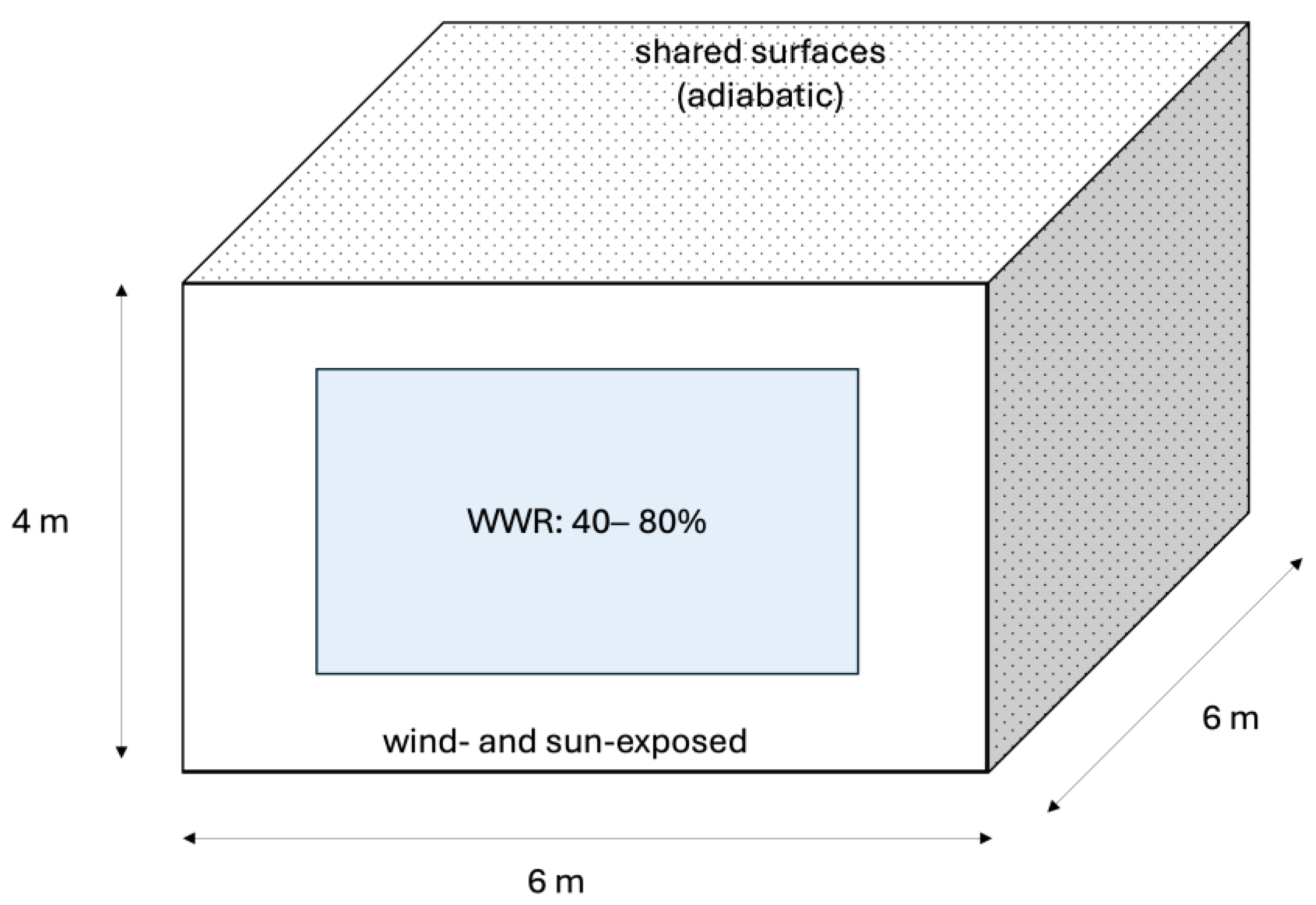
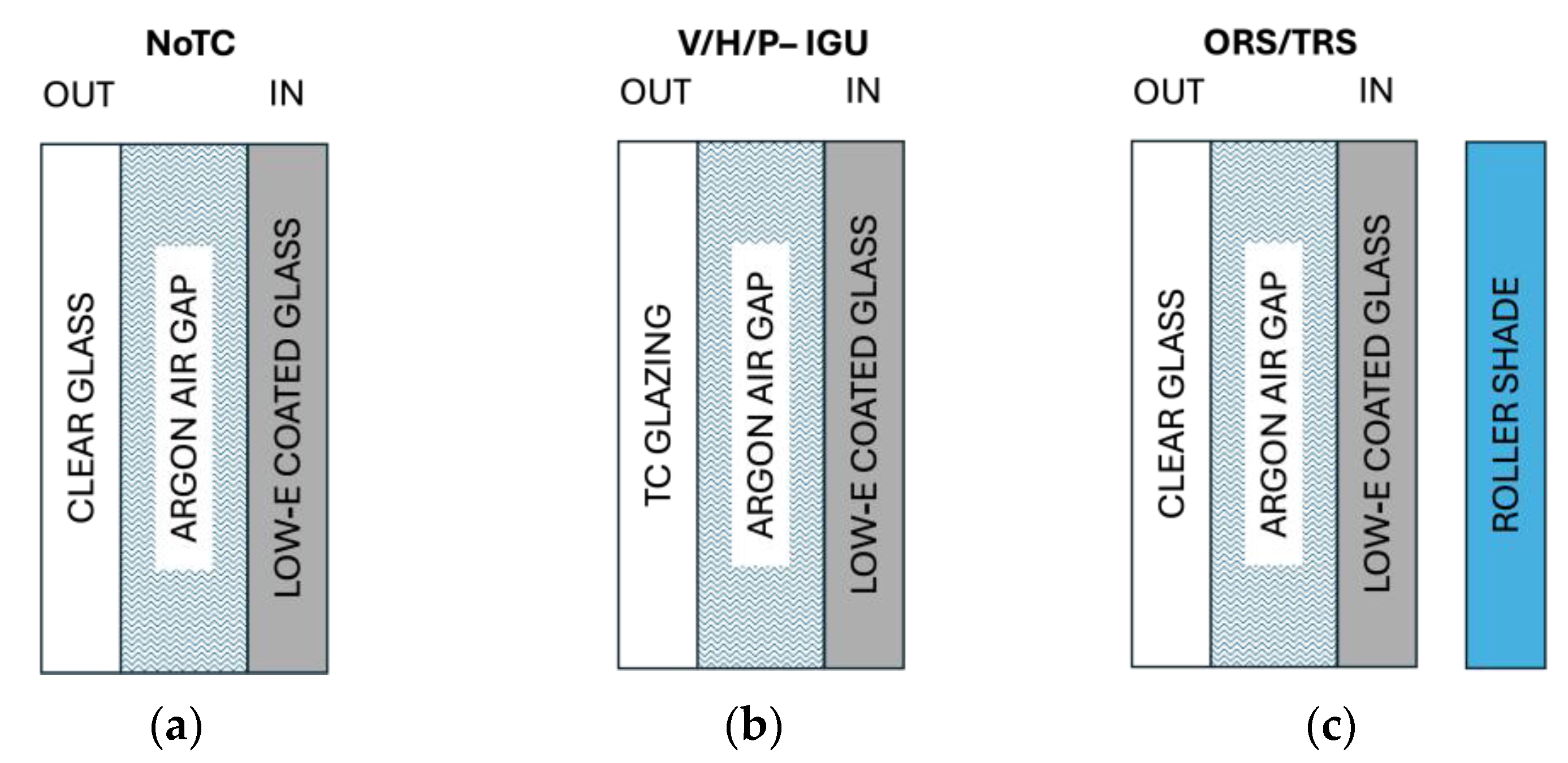


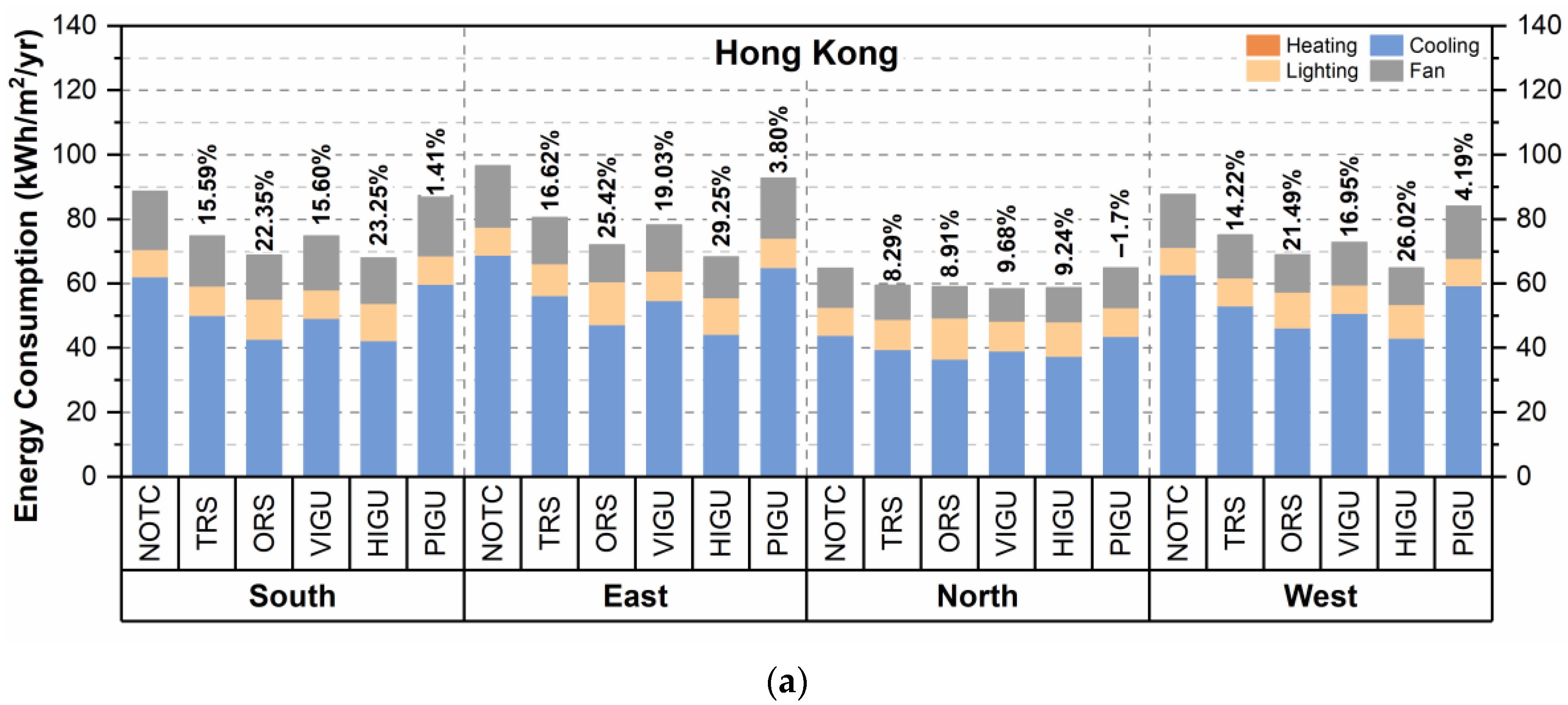

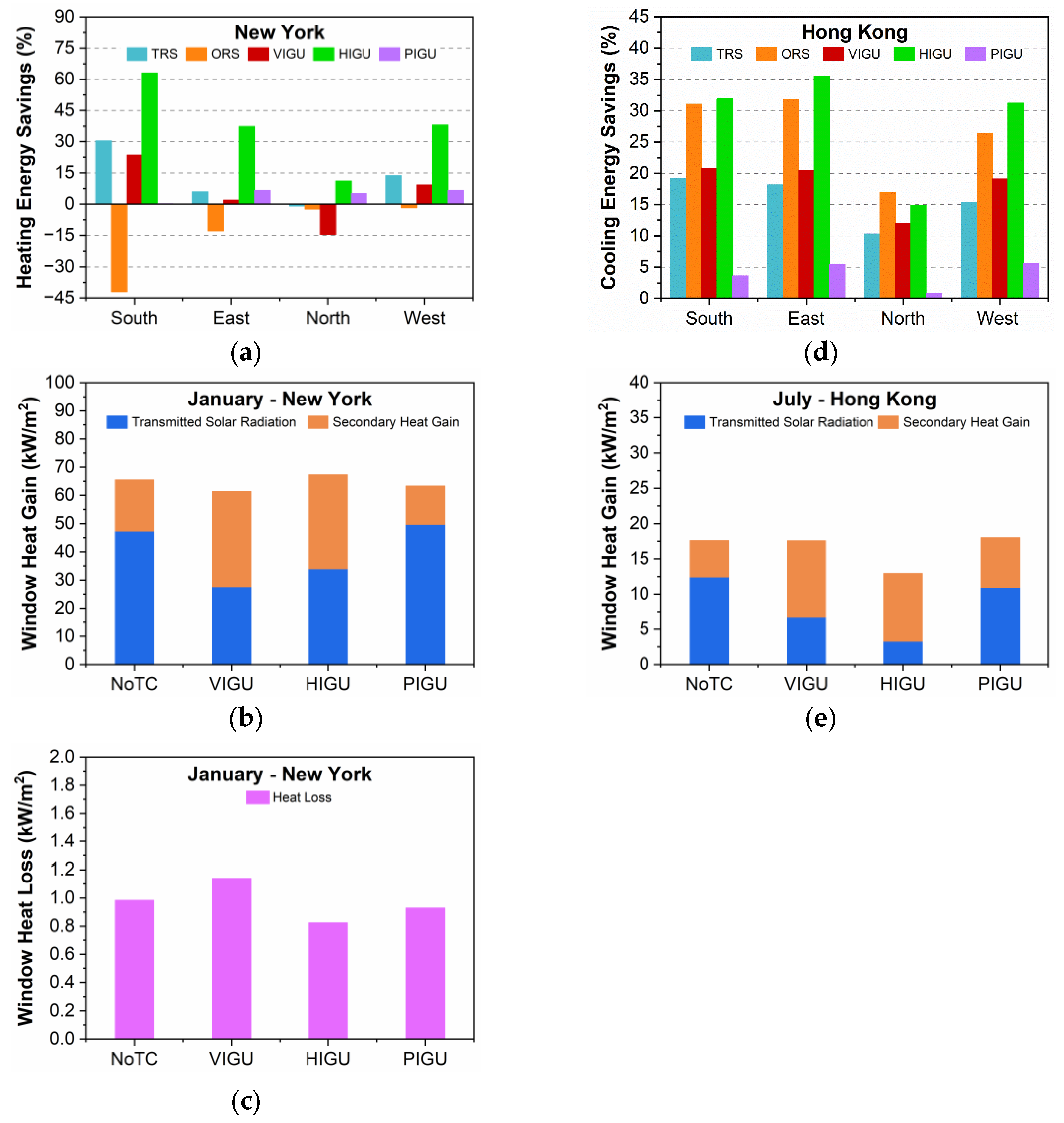
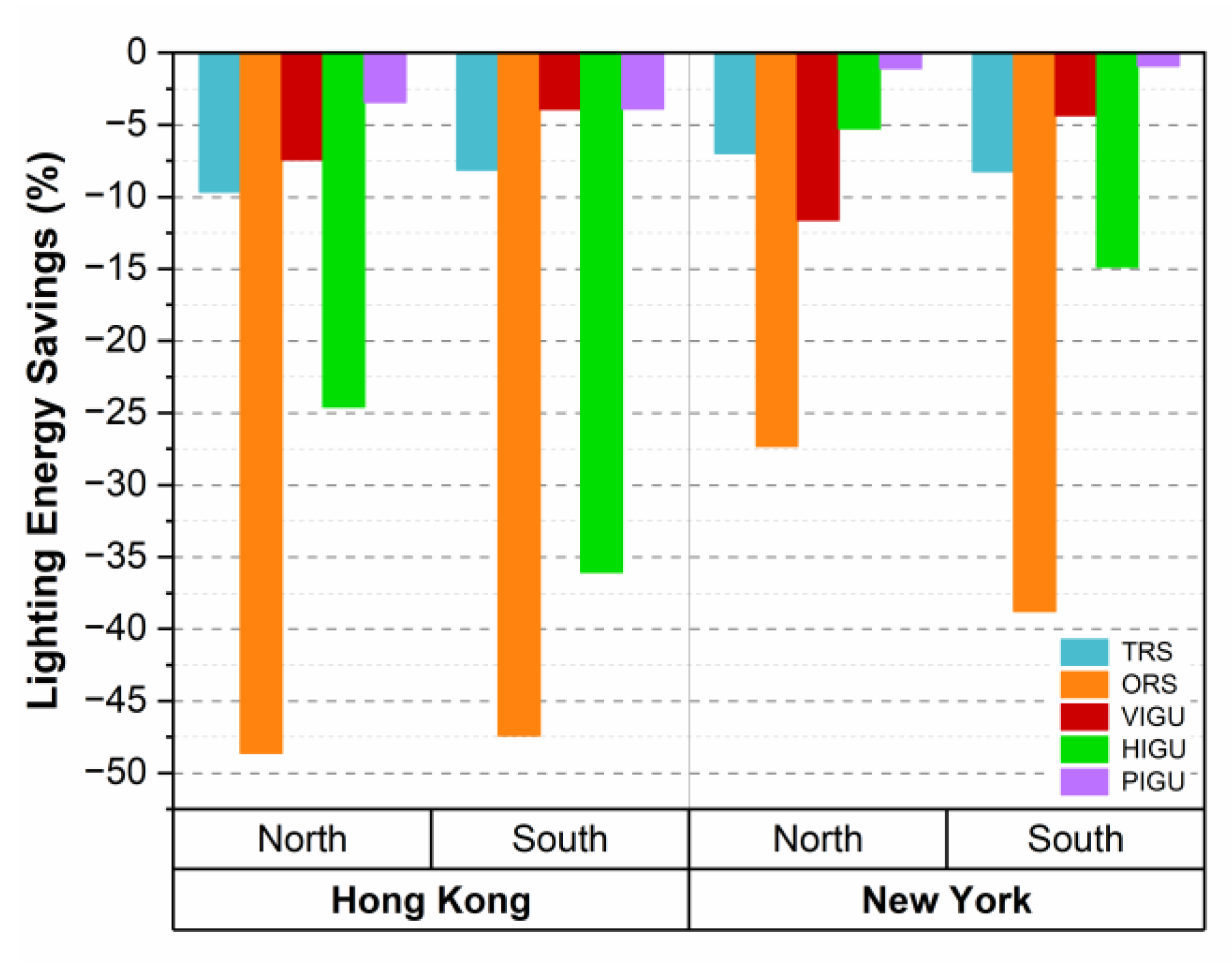
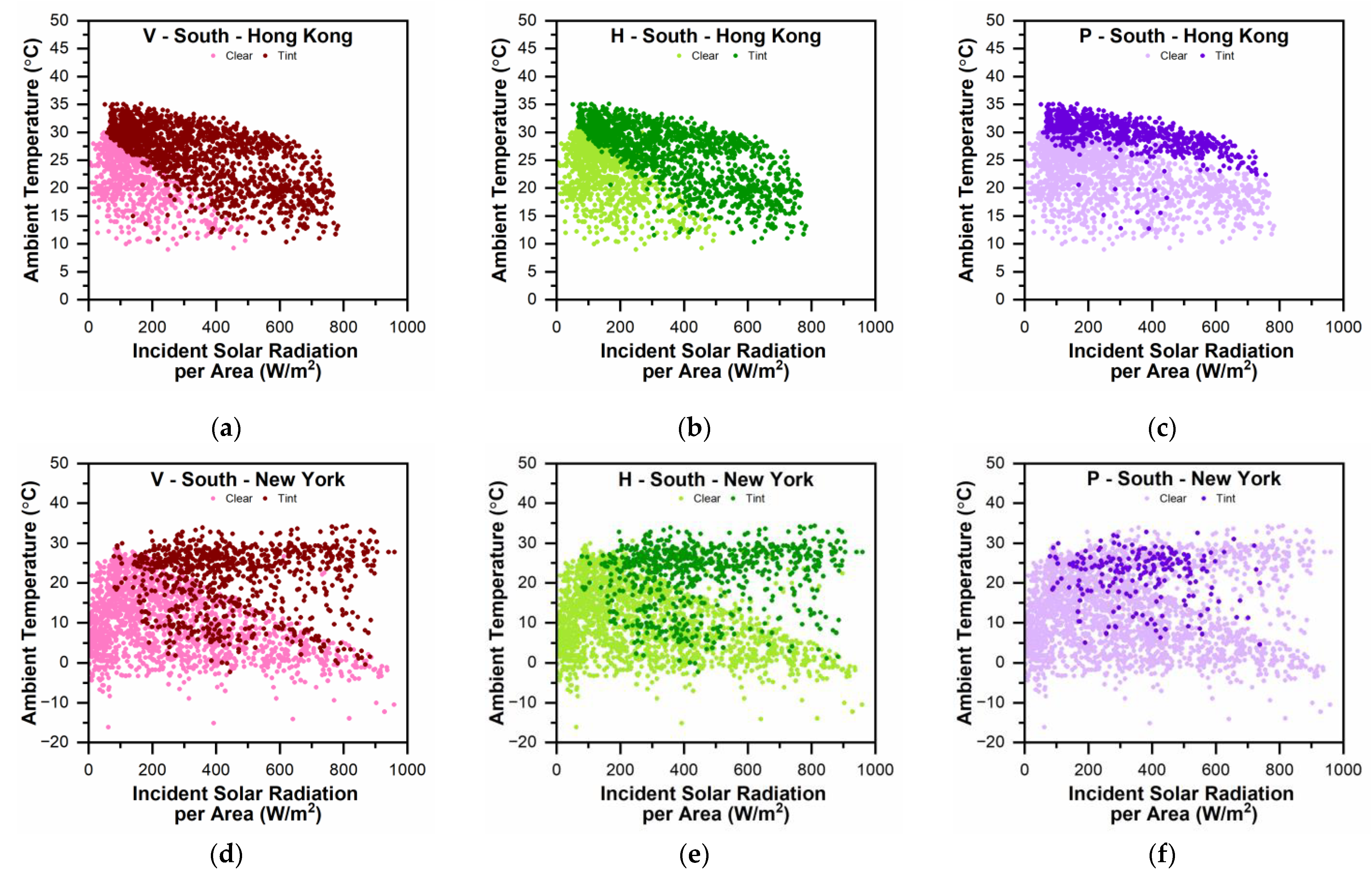
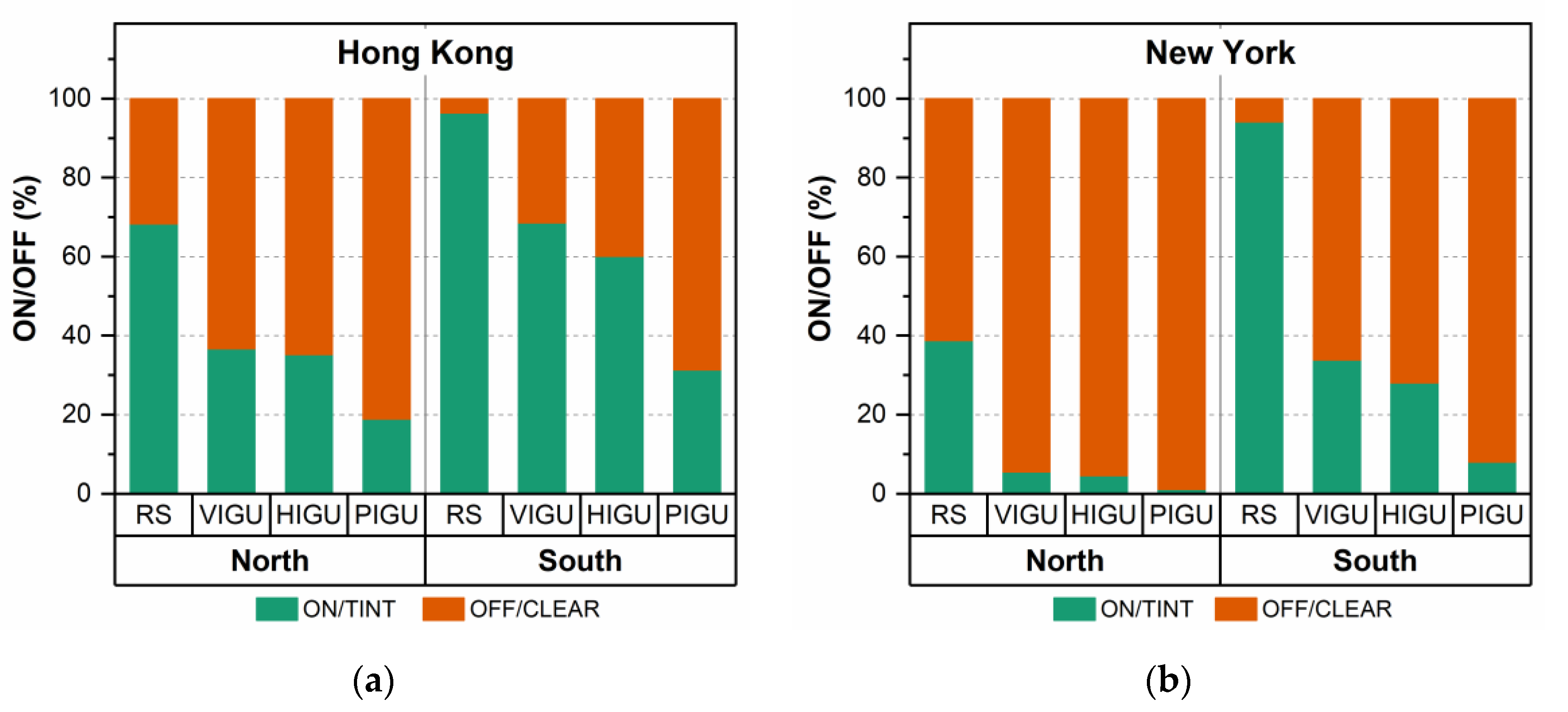
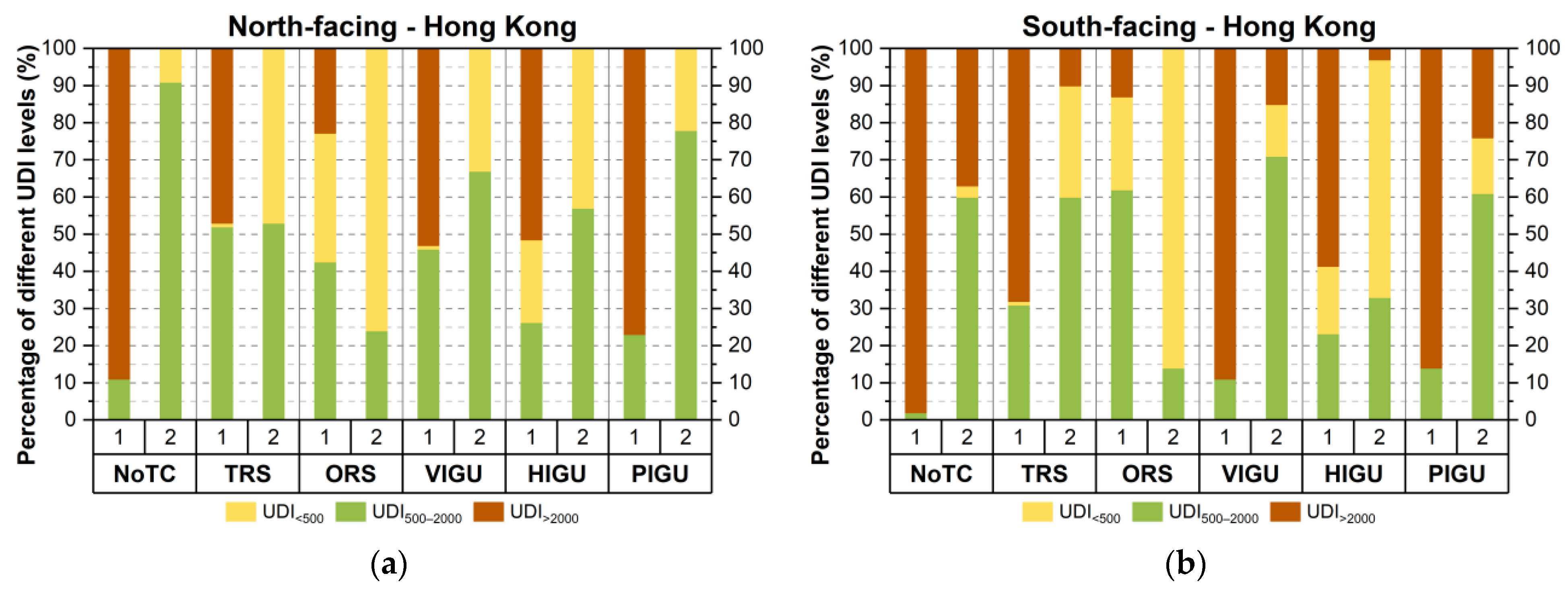
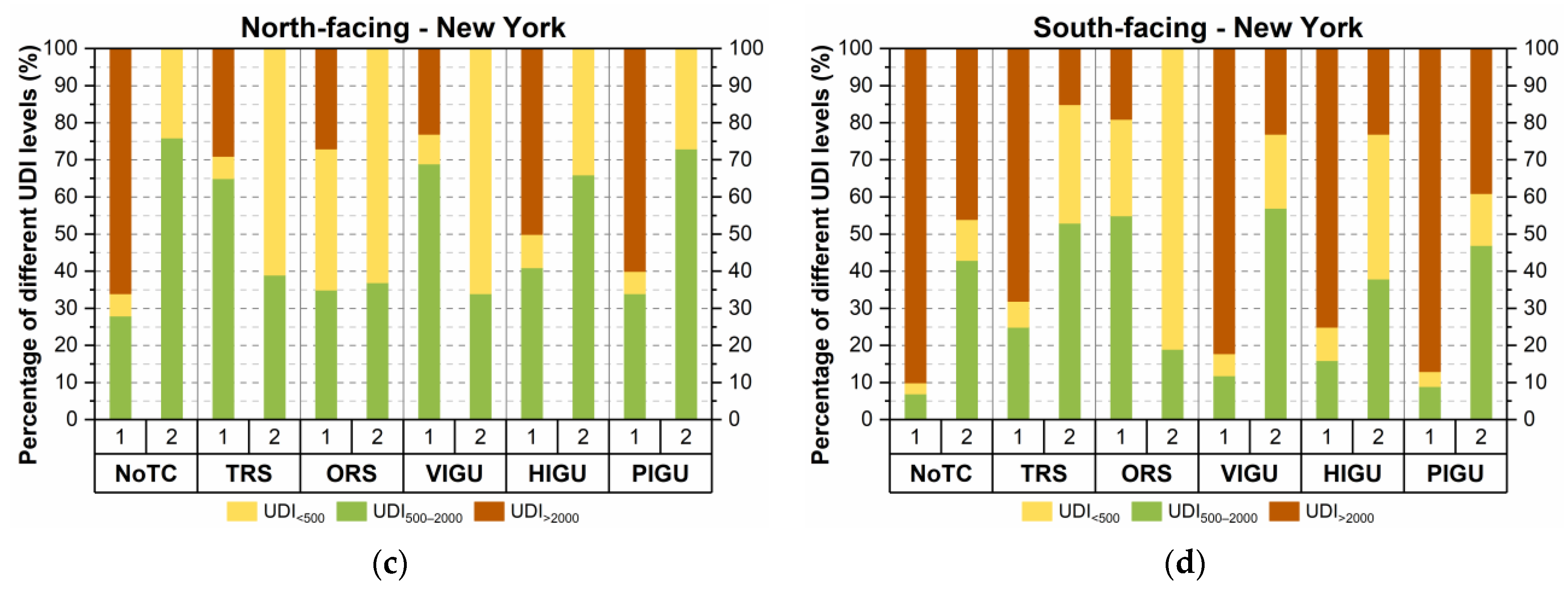
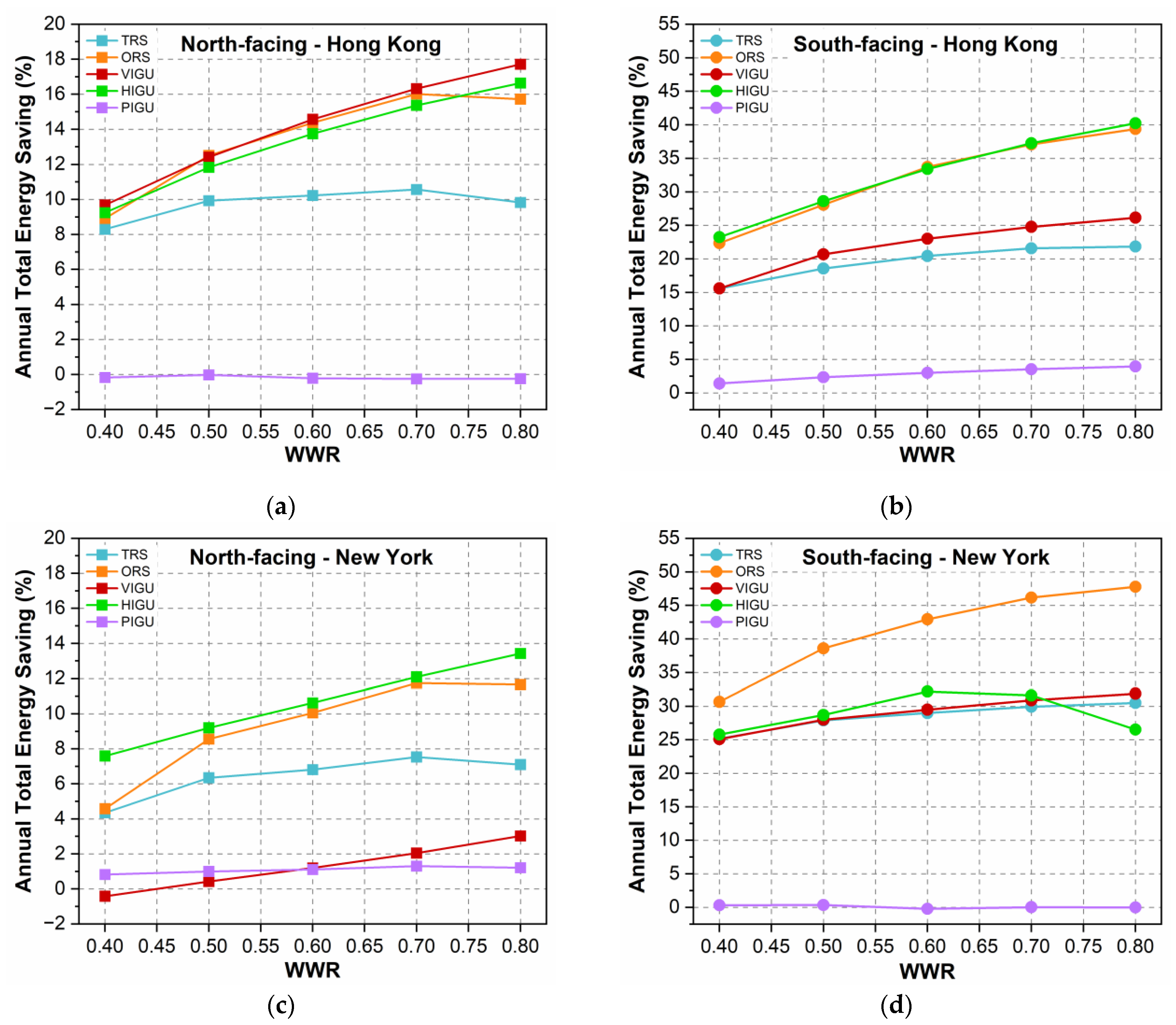
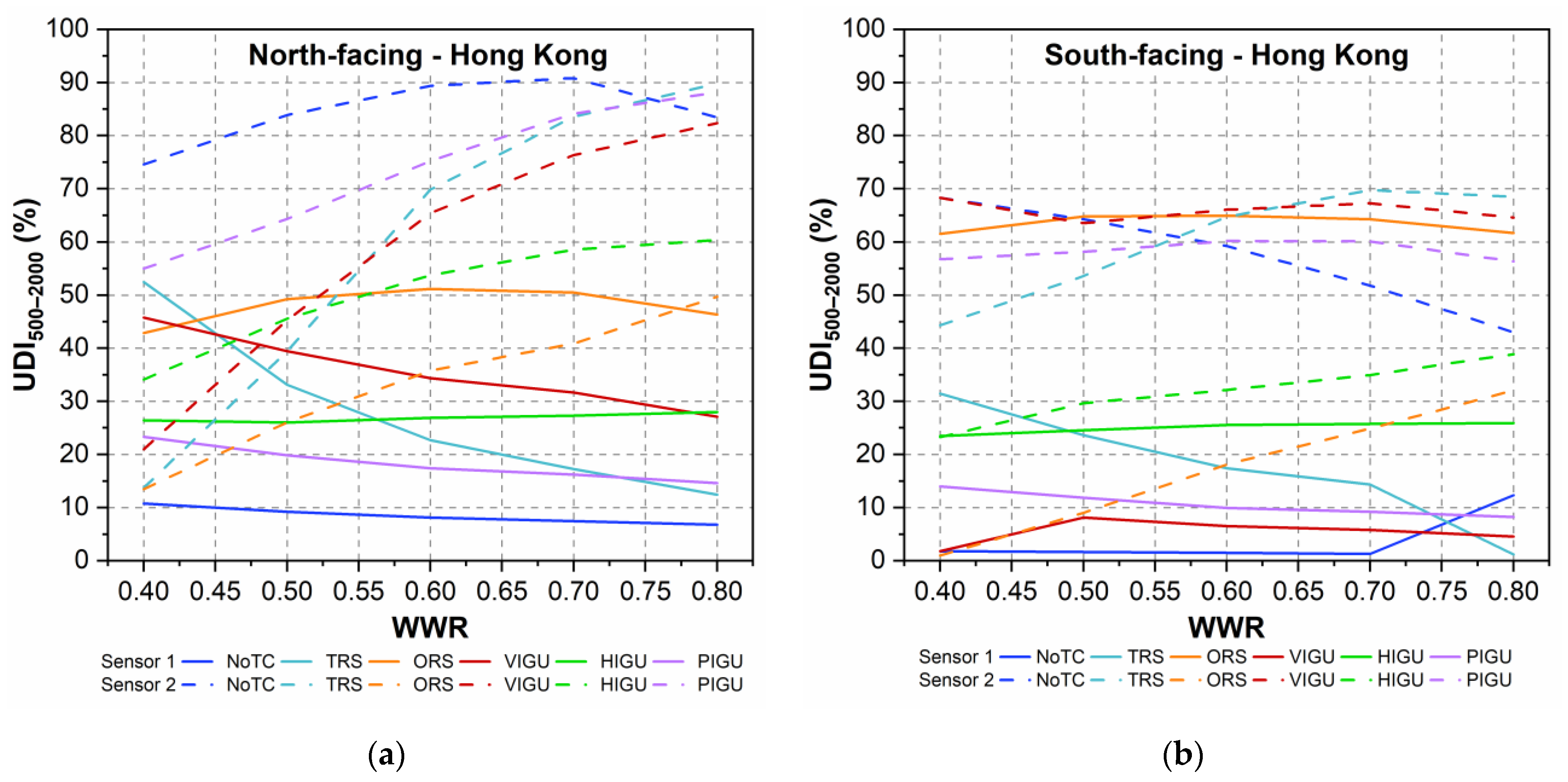
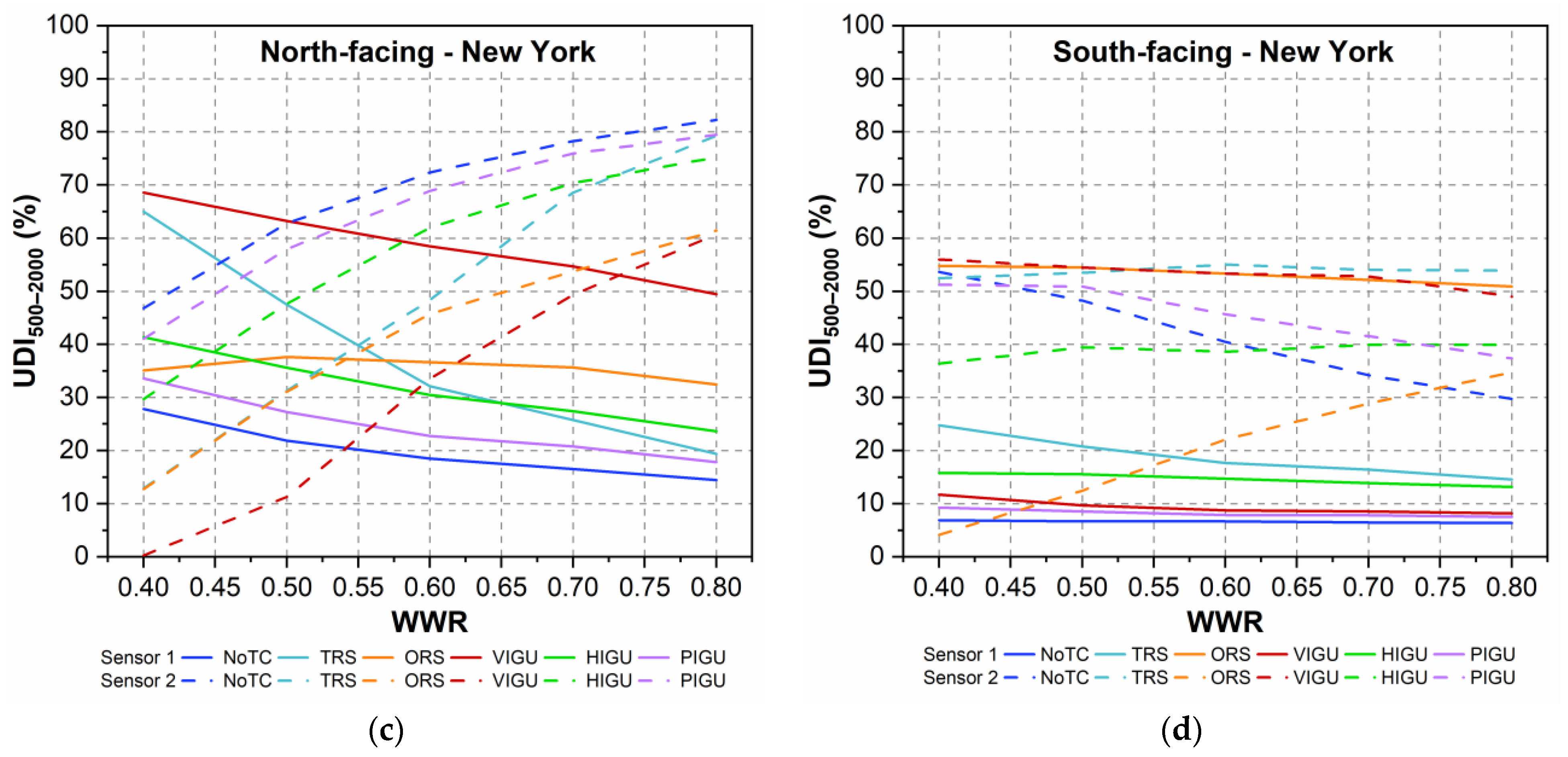
| Region | HDD65 | CDD65 | Heating Design Temperature | Cooling Design Temperature | Cloudiness (Hours Annually) | |||
|---|---|---|---|---|---|---|---|---|
| 99.6% | DryBulb | WetBulb | Clear | Partly Cloudy | Cloudy | |||
| Hong Kong | 305 | 4746 | 9.6 °C | 32.2 °C | 26.5 °C | 3859 | 3747 | 1154 |
| New York | 6147 | 637 | 10.7 °C | 32.1 °C | 23.1 °C | 1504 | 2118 | 5138 |
| Hong Kong | New York | |||||
|---|---|---|---|---|---|---|
| Exterior Wall | Interior Wall | Interior Ceiling/Floor | Exterior Wall | Interior Wall | Interior Ceiling/Floor | |
| Layer 1 (outermost) | Tile | Gypsum | Gypsum | Stucco | Gypsum | C/F Concrete |
| Cement/sand | Interior Concrete | C/F Concrete | Exterior Concrete | Wall Air | Ceiling Air | |
| Exterior Concrete | Insulation 1 | |||||
| Layer N 2 (innermost) | Gypsum | Gypsum | C/F Tile | Gypsum | Gypsum | Acoustic Tile |
| U-value 3 | 2.135 | - | - | 0.449 | - | - |
| Low-E | Clear | H_cold | H_hot | P_cold | P_hot | V_cold | V_hot | RSt | RSo | |
|---|---|---|---|---|---|---|---|---|---|---|
| Solar transmittance | 0.710 | 0.834 | 0.657 | 0.069 | 0.869 | 0.612 | 0.480 | 0.425 | 0.4 | 0.1 |
| Solar reflectance | 0.190 | 0.075 | 0.076 | 0.554 | 0.087 | 0.088 | 0.225 | 0.191 | 0.5 | 0.8 |
| Visible transmittance | 0.876 | 0.899 | 0.784 | 0.067 | 0.853 | 0.303 | 0.491 | 0.489 | 0.4 | 0.1 |
| Visible reflectance | 0.092 | 0.083 | 0.070 | 0.750 | 0.095 | 0.079 | 0.275 | 0.232 | 0.5 | 0.8 |
| IR emissivity (inner) | 0.068 | 0.840 | 0.350 | 0.920 | 0.774 | 0.785 | 0.840 | 0.840 | 0.9 | 0.9 |
| Shade to glass distance (m) | - | - | - | - | - | - | - | - | 0.05 | 0.05 |
| New York | Hong Kong | |||||||||
|---|---|---|---|---|---|---|---|---|---|---|
| TRS | ORS | V | H | P | TRS | ORS | V | H | P | |
| North | 60% | 60% | 70% | 40% | X 1 | 50% | 80% | 50% | X | X |
| East | 80% | X | 50% | X | X | 40% | X | X | 50% | X |
| South | X | X | X | X | X | X | X | X | 40% | X |
| West | X | 70% | 50% | X | X | X | 60% | X | 40% | X |
Disclaimer/Publisher’s Note: The statements, opinions and data contained in all publications are solely those of the individual author(s) and contributor(s) and not of MDPI and/or the editor(s). MDPI and/or the editor(s) disclaim responsibility for any injury to people or property resulting from any ideas, methods, instructions or products referred to in the content. |
© 2024 by the authors. Licensee MDPI, Basel, Switzerland. This article is an open access article distributed under the terms and conditions of the Creative Commons Attribution (CC BY) license (https://creativecommons.org/licenses/by/4.0/).
Share and Cite
Tennakoon, T.; Chan, Y.-H.; Chan, K.-C.; Wu, C.; Chao, C.Y.-H.; Fu, S.-C. Energy Performance and Comfort Analysis of Three Glazing Materials with Distinct Thermochromic Responses as Roller Shade Alternative in Cooling- and Heating-Dominated Climates. Buildings 2024, 14, 1157. https://doi.org/10.3390/buildings14041157
Tennakoon T, Chan Y-H, Chan K-C, Wu C, Chao CY-H, Fu S-C. Energy Performance and Comfort Analysis of Three Glazing Materials with Distinct Thermochromic Responses as Roller Shade Alternative in Cooling- and Heating-Dominated Climates. Buildings. 2024; 14(4):1157. https://doi.org/10.3390/buildings14041157
Chicago/Turabian StyleTennakoon, Thilhara, Yin-Hoi Chan, Ka-Chung Chan, Chili Wu, Christopher Yu-Hang Chao, and Sau-Chung Fu. 2024. "Energy Performance and Comfort Analysis of Three Glazing Materials with Distinct Thermochromic Responses as Roller Shade Alternative in Cooling- and Heating-Dominated Climates" Buildings 14, no. 4: 1157. https://doi.org/10.3390/buildings14041157
APA StyleTennakoon, T., Chan, Y.-H., Chan, K.-C., Wu, C., Chao, C. Y.-H., & Fu, S.-C. (2024). Energy Performance and Comfort Analysis of Three Glazing Materials with Distinct Thermochromic Responses as Roller Shade Alternative in Cooling- and Heating-Dominated Climates. Buildings, 14(4), 1157. https://doi.org/10.3390/buildings14041157







